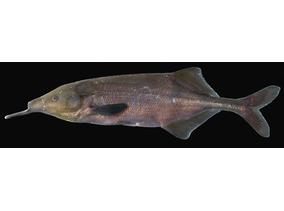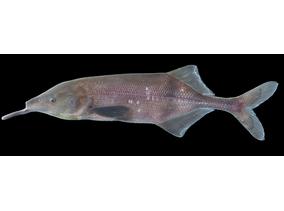You are here
Mormyridae
Gnathonemus echidnorhynchus Pellegrin, 1924
Nomenclature
-
Subfamily: MormyrinaeGenus: Gnathonemus
SUMMARY
General Description: after Pellegrin 1924, pp. 5-6.
The height of the body is contained 4 1/4 to 4 3/4 times in length, excluding caudal, the length of the head 3 1/2 to 3 3/4 times. The head is about 1 2/3 times as long as high. The snout, directed forward and pointed, is slightly shorter than postocular region of head. The large diameter of the eye is included 2 1/2 to 3 times in snout length, 1 1/2 to 2 times in the interorbital space, 6 2/3 to 7 1/2 times in head length. Mouth, terminal, opens at the lower edge of the eye and is very narrow and filled with 4 or 5 small bicuspid teeth above, 6 or 7 below. The chin is extended into a long pointed appendage, directed forward, matching the length of the snout. There are 65-69 scales along the lateral line, 12-13 / 14-16 in transverse line, 9-11 / 9-11 between dorsal and anal, 12 around the caudal peduncle . Dorsal rays 26 or 27, starting above the 6th or 7th ray of anal; length of its base is about half the distance to the head and is equal to or slightly greater than its distance from the caudal. Anal 32 to 33, slightly closer to the origin of caudal fin than that of the ventral. Pectoral, obtusely pointed, 3/5 of head length; about twice the ventral, which it reaches by 1/2 to 3/4 of its length. The caudal peduncle is about 3 times as long as high. The tail, scaly at the base, with its pointed lobes. D. 26-27; A. 32-33; P. 11; V. 6; Scales 12-13/65-69/14-16
The color is yellowish brown with indistinct traces of a black stripe running from the beginning of the dorsal to that of anal. The fins are brownish.
This curious fish with its [chin] extended almost [directly forward], slightly shorter than postocular region which is vaguely reminiscent, chin barbel excluded, of the head of the Echidna, resembles somewhat Gnathonemus longibarbis Hilgendorf, of Lake Victoria. However, it is distinguished easily by its longer and more slender snout and its shorter dorsal and anal fins.
Size: to 130 mm SL (excluding chin barbel)
EOD and electric organ: The EOD waveform is between 0.4-0.5 millesconds in duration. There is a relatively weak head-negative pre-pulse followed by a broad positive (P1) phase and a shorter negative (P2) phase.
Link to EOD waveforms archived in the Macaulay Library
Distribution: Congo River Basin, including Kasai, Kwilu and Lualaba and affluents. Uncommon in collections and distribution not well understood. May prefer black water habitats.






